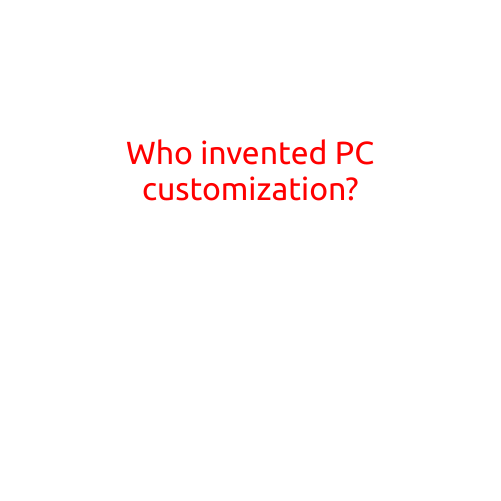
Who Invented PC Customization?
PC customization has come a long way since its inception in the 1970s. From hand-built computers to intricate liquid cooling systems, the art of personalizing a PC has evolved significantly. But who exactly invented PC customization and how did it become a staple in the tech world?
The Early Days
The concept of PC customization dates back to the 1970s, when hobbyist computer enthusiasts began tinkering with off-the-shelf components to create their own unique machines. These early pioneers, often referred to as “hacker” or “computer klutz,” would modify their computers to improve performance, add new features, and push the boundaries of what was possible.
One of the earliest known examples of PC customization is credited to Peter G. Neumann, a computer engineer who built his own computer from scratch in 1972. Neumann’s machine, known as the “Neumann Computer,” featured a custom-built motherboard, a CRT display, and a membrane-based keyboard. Although not widely recognized at the time, Neumann’s project laid the groundwork for future generations of PC enthusiasts.
The Rise of the DIY Community
The 1980s saw the emergence of the DIY (Do-It-Yourself) community, where enthusiasts would share their knowledge, plans, and experiences with customizing their computers. This era also witnessed the rise of computer magazines, such as Computer Shopper and Byte, which provided blueprints, tutorials, and reviews of custom-built computers.
One notable figure from this period is John “Maddox” Santilli, who co-founded the legendary computer magazine, Compute!’s Gazette. In the 1980s, Santilli published numerous articles and projects on customizing IBM compatible PCs, including the famous “Maddox’s MoBo” article, which showcased a comprehensive guide on building custom motherboards.
The Advent of Overclocking
The 1990s marked the beginning of overclocking, a phenomenon that would revolutionize PC customization. AMD’s K5 processor, released in 1996, was the first to introduce speed-enhancing features, which encouraged enthusiasts to push their CPU speeds beyond the manufacturer’s recommended specifications. Overclocking quickly became a benchmark of PC customization, with enthusiasts competing to achieve the highest clock speeds and most efficient cooling systems.
Current Trends and Future Directions
Today, PC customization is a multibillion-dollar industry, with options ranging from pre-built gaming PCs to high-end liquid cooling solutions. The rise of social media platforms, online forums, and special interest groups has created a global community of PC enthusiasts who share their creations, showcase their builds, and collaborate on new projects.
As we look to the future, PC customization is likely to continue evolving, driven by advancements in technology and the growing demand for personalized computing solutions. With the resurgence of retro gaming and the popularity of gaming PCs, the art of customization is set to continue fascinating and inspiring generations of computer enthusiasts.
Conclusion
While it is difficult to attribute the invention of PC customization to a single individual or group, pioneers like Peter G. Neumann, John “Maddox” Santilli, and the DIY enthusiasts of the 1970s and 1980s laid the groundwork for the vibrant community we see today. As PC customization continues to push boundaries and redefine what is possible, it is essential to acknowledge the spirit of innovation and experimentation that has driven this remarkable journey.





